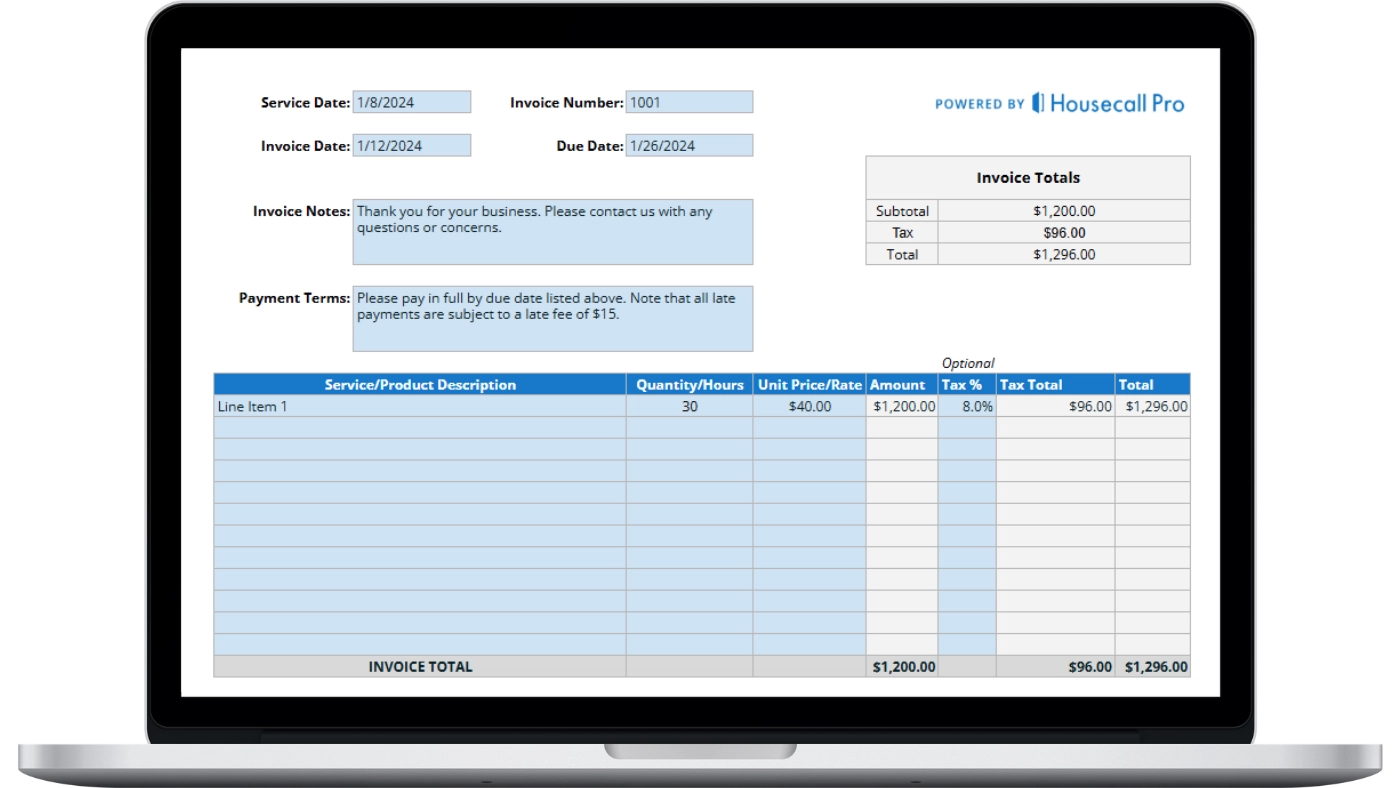
Being an electrical contractor means having a specific set of skills that not many can offer. Because of the inherent dangers of working with electrical currents, contractors also command a certain amount of money for the job that they do.
The question becomes, “How much do electrical company owners make?” The total can change drastically the further you get from the top of the food chain, but it is an important question to ask. In this guide, we will learn about markups, profit margins, overhead percentages, bidding on jobs, and everything that an electrical contractor could need to know.
What is the Standard Markup for Electrical Contractors?
The markup for electrical contractors depends on the current industry standard as well as the location of service.
Generally speaking, however, the average markup is somewhere around 2x-6x what you paid for those materials.
Profit goals for the company can play a factor. Labor costs and what the market itself can handle are important to know as well. All in, a gross profit margin (more on that below) of 65-67% is a good place to aim. The key is to apply one markup multiplier across each of the materials and parts that you use.
Having different markups for smaller jobs vs. bigger jobs will create inconsistent margins. In the end, that can wind up being difficult to keep track of, especially for the bookkeepers. Correctly determining markup also helps determine what your company’s billable labor rate will be. Calculating a reliable hourly rate will cover overhead costs, and labor, and tell you things like break-even rate per sold hour.
When combined with equipment and material markups, contractors can then calculate the retail prices of specific services. Clear pricing levels make it less confusing for the customer and ensure that your business overhead and gross profit margin are accounted for.
What is a Good Profit Margin for Electrical Contractors?
Another important factor to consider is profit margin. Remember that this line of work is highly skilled and comes with a certain level of risk. It is not out of the realm of possibility for electrical contractors to shoot for around 20% net profit when it comes to their business. Obviously, certain factors can change that, but it is the high-end to work for.
For many electrical contractors, falling within the 10-20% range is considered to be a reasonable net profit margin.
Unfortunately, many skilled contractors operate under that 10% bar for a variety of reasons, one of which is because they have lower estimates than may be necessary.
Some businesses operate with profit margins as low as 2-3%. There are any number of risks and costs that come with running an electrical company and not being properly compensated for the effort and risk only leaves the door open for further issues.
Aiming for a 20% profit margin after subtracting material and equipment costs, labor costs, and operating expenses (office supplies, taxes, business insurance, etc.) should be the goal. Getting within the 10-20% range is ideal, though startups will face greater challenges reaching that mark and may want to focus on customer acquisition initially rather than being profitable.
What is the Average Overhead Percentage for Electrical Contractors?
Though the work and invoicing may take precedence when it comes to electrical contractor profit margin, overhead plays an important role as well. The question, “How much do electrical company owners make” can only be answered when you factor in what it costs to run the business in the first place.
Overhead is the recurring cost of what it takes to run the business. Though overhead can be adjusted and vary depending on the business, it includes things like utilities, rent/lease agreements, paying employees, insurance, buying/renting equipment, and a litany of other things.
No matter how big the job or how busy your shop may be, overhead is part of the process. Overhead also doesn’t include labor, materials, or job expenses specifically needed to complete the job. How much or little is spent on overhead depends on the number and size of the jobs that your company takes on.
On average, electrical contractors factor in overhead to account for roughly 13-20% of total sales.
While the natural goal may be to keep overhead costs as low as possible, it should never interfere with the quality of the work being done. Far too many business owners attempt to cut overhead to keep costs lower even if it has an impact on quality and performance.
What Gross Profit Margin Should an Electrical Company Owner Target?
Though we talked about net profit margin above – how much a company should make after all fees and expenses have been factored in – it is important to discuss gross profit margin as well. Each of these margins plays an important role in determining how much the business is bringing in.
While net profit margin should ideally hover anywhere from 10% to 20%, gross profit margin should be much higher.
Electrical businesses should have their ideal gross profit margin somewhere in the 65-67% range for their services.
Gross profit margins are also important because they are used to measure the performance of the business. Even more critical, gross profit margins can be used to compare departments like how new construction, maintenance, service and repair, or electrical installation are doing. It is a fantastic way to gauge strengths, assess weaknesses, and make adjustments to your business model.
How to Improve Electrical Profit Margins
Most business owners will want to find a way to increase electrical contractor profit margin. There are a few ways to do that. Check out the three best ways to improve your company’s profit margins and keep more money in the coffers.
Raise Prices
The simplest way to grow profit margins is by raising prices. That said, many electrical contractors are hesitant to do so because the fear is that they will lose business. There may be a slight drop in sales, but profit margins will increase. Moreover, the customers that are going to haggle likely aren’t going to be long-term customers anyway.
Test out price increases over a specified period of time and look at the results. Salespeople need to be on the same page so that they can convince customers that the markup is reasonable and justified. Adding things like gas charges will help to offset specific costs, creating better profit margins in the long run.
A steep rise in price can be off-putting. Marginal increases coupled with solid communication can help profit margins over time. Repeat customers will return for the quality of service being provided, even if prices are slightly higher than they used to be.
Pay Less for Materials, Equipment, etc.
Negotiating or buying power with suppliers depends on how much you spend on materials and equipment. Big contractors typically have the edge on bigger discounts because they buy more. To narrow that gap, it may be beneficial to join a group purchasing program. These programs work with manufacturers and distributors with a greater collective purchasing power.
Group purchasing programs can help garner larger discounts from suppliers, improving gross profit percentages immediately. Office supplies, uniforms, shipping, and other costs can be cut by up to 50%, depending on the program. These groups also typically have tools that find items at the lowest price while also getting supply chain alerts that save time and money.
Expand Your Reach
The true key to larger profit margins is to find unique markets. For instance, working with EV charging stations, solar and microgrids, smart panels, etc. can provide new avenues of work. Not every electrical contractor covers those areas, which means being able to not only meet a niche need but being able to charge more for that work.
The commercial and residential electrical markets are estimated to grow exponentially over the next 5-7 years. With a larger movement to electrification, there are opportunities for electrical contractors to grow their businesses. Though the volume of work may not be as frequent as standard electrical services, the profit margins will be much, much higher.
Grow Your Business with Electrical Contractor Software
A must-have tool for any electrical contractor is electrical contractor software. Any company, large or small, can benefit from automating daily tasks, reducing the chance of errors and inaccuracies, developing leads, and so much more.
You can sign up for a 14-day free trial with Housecall Pro and take advantage of our electrical contractor software. In no time at all, your business can see the benefits that only great electrical contractor software can bring to the table.
Invoicing
Proper invoicing is essential for any business. As electrical contractors, it is imperative to be paid in a timely manner for the work being done. With proper electrical contractor software, invoicing can be streamlined to limit confusion and ensure that customers pay on time.
Utilizing Housecall Pro’s contractor software, virtually every base can be covered. Convert estimates into invoices and jobs instantly. Create reminders to follow up on past-due invoices. Change and track different payment methods like credit and debit cards, ACH, cash, check, and more. Even financing can be provided to customers, opening up another potential avenue to loyal customers.
Get In Touch: 858-842-5746
Let us earn your trust
On average, Pros increase monthly revenue generated through Housecall Pro by 50% after their first year.
See plan options and feature breakdown on our pricing page.
Job Management
Job management, from small to large, is critical to the structure of the business. Housecall Pro’s software provides electrical contractors with the job management capabilities needed to keep everything flowing and moving along efficiently.
Each job can have its own checklist created to ensure that everything has been accounted for. Customer and property information can be easily organized, employee payroll and health benefits can be accounted for, and even real-time reporting on revenue, profits, and job costs can be calculated. Information is critical and can be called up at a moment’s notice with the right electrical contractor software.
Better Communication
Things can change at a moment’s notice. Having effective communication can be a game-changer, ensuring that everyone in the business is on the same page. Great communication between the home office and field technicians ensures that each job stays on track and that problems are solved in real time.
Electrical contractor software allows everyone to stay connected. There is no need for endless calls, texts, and emails that could go unanswered. With improved communication comes a better flow of information, more wrench time, and even a reduced workload. Most importantly, it means avoiding potential frustration from workers.
Easily Access information
Completing an electrical service job comes down to having the right information. Where to be, when to be there, what tools and equipment are needed for the job, etc. Even one missing component can throw the entire job into disarray. Thankfully, electrical contractor software can ensure that information is easily accessible.
With mobile field software, technicians never need to be disconnected from the office. They can access photos, drawings, documents, job checklists, service histories, and more all from one device. Any question that the customer may have, the technician can quickly and easily call up the right answer.
Improve Customer Service
Customer satisfaction is crucial to maintaining a loyal customer base. While other factors come into play, the work done is what keeps bringing customers back. Essential to great customer service is electrical contractor software. Those repeat customers are necessary to improve electrical contractor profit margin over time.
Effective communication and knowledgeable technicians are key to providing exceptional service. Building a good relationship with customers also means following up to ask important questions, schedule future service, and more. Electrical contractor software can make it far easier to communicate to customers that your business can handle a litany of services.
How to Bid on Electrical Jobs
Part of bringing in customers is knowing how to bid on an electrical job. Each job is unique and has certain factors that make it more or less attractive to contractors. Having a few helpful tips going into the process can streamline the process and make winning more bids possible.
Choose the Best Jobs
That doesn’t necessarily mean picking the ones that pay the most, but the ones with which your business has experience. Having more experience means being able to bid with greater accuracy, ensuring that costs don’t wind up cutting into profit margins on each job.
Review Job Specs
Before bidding on a job, review all of the drawings, notes, and blueprints for the job. Check out the specifications for the job in order to accurately price out jobs. Electrical drawings are ideal because they add a greater level of detail; notes may be incomplete and exclude essential pieces of information.
Calculating Material Needs
Without the proper materials, no job will get done the right way. Estimating material costs can also be the biggest potential drain on profit margins. Create a list of all items and materials needed to get the job done. That said, having a separate list for individual tasks is ideal because then costs per task can provide a true breakdown of where expenses are.
Know Labor Costs
What is it going to cost your business to physically do the job? When all materials have been accounted for, it’s time to know what labor is going to cost. These costs can be calculated by labor unit, burdened labor costs, and supervision costs.
Create Your Estimate and Calculate Overhead
The time then comes to create your estimate. With labor, materials, and other costs in tow, you can get a better idea of what the job will cost as a whole. Which also means knowing the overhead needed to run each job. A percentage of overhead will go into each job, but each business should have an idea of overhead ahead of time.
Build a Proposal and Check Your Estimate
With overhead, profit, and costs now calculated, it is time to build a proposal. In this stage, your business will create a desired bid for the job. Before submitting the bid, check the accuracy. Review all aspects of the estimate because even a simple mistake can wind up costing you the job.
Submit the Bid
If you have the capacity, submit your bid electronically. Not only does this save time, but it also allows for a faster bid, and clients or customers can review and potentially accept right then. Electronic submissions are also great for answering questions or providing additional details to potential customers.
Final Thoughts
There are several factors that can contribute to a better profit margin for your electrical contractor business. Sign up for Housecall Pro’s 14-day free trial today and begin to see the benefits for your business. With better scheduling, improved invoicing, and a host of other tools, running an efficient and effective company has never been easier.






